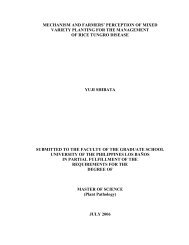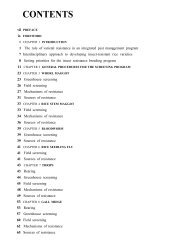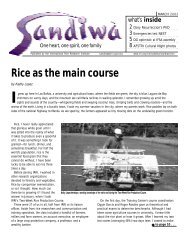Untitled - International Rice Research Institute
Untitled - International Rice Research Institute
Untitled - International Rice Research Institute
You also want an ePaper? Increase the reach of your titles
YUMPU automatically turns print PDFs into web optimized ePapers that Google loves.
Sarocladium oryzae (Sawada) W. Gams & D. Hawks.<br />
syn. Acrocylindrium oryzae Saw.<br />
Sarocladium attenuatum W. Gams & D. Hawks.<br />
Disease caused: sheath rot<br />
a. Symptoms<br />
Lesions start at the uppermost leaf sheath enclosing<br />
young panicles as oblong or irregular spots,<br />
with brown margins and gray center or brownish<br />
gray throughout. Spots enlarge and coalesce covering<br />
most of the leaf sheath. Panicles remain<br />
within the sheath or may partially emerge. Affected<br />
leaf sheaths have abundant whitish powdery<br />
mycelium. The pathogen infects rice plants<br />
at all growth stages, but it is most destructive after<br />
the booting stage.<br />
b. Occurrence/distribution<br />
Sarocladium oryzae is present in all rice-growing<br />
countries worldwide (Fig. 33). Sheath rot has become<br />
more prevalent in recent decades and is<br />
very common in rainfed rice or rice during the<br />
rainy season.<br />
c. Disease history<br />
Sawada first described sheath rot of rice in 1922<br />
from Taiwan. He named the causal organism as<br />
Acrocylindrium oryzae. In 1975, Gams and<br />
Hawksworth reclassified the causal organism as<br />
Sarocladium oryzae after comparing their isolates<br />
with those of Sawada.<br />
d. Importance in crop production<br />
Densely planted fields and those infested by stem<br />
borers are susceptible to S. oryzae infection. The<br />
fungus tends to attack leaf sheaths enclosing<br />
young panicles, which retards or aborts the emergence<br />
of panicles. Seeds from infected panicles<br />
become discolored and sterile, thereby reducing<br />
grain yield and quality.<br />
Detection on seed<br />
a. Incubation period on blotter<br />
Using the blotter test, S. oryzae can be observed<br />
on rice seeds 7 d after seeding and incubated under<br />
NUV light conditions at 21 °C. The detection<br />
frequency is about 21.3% on seeds coming from<br />
different regions (Fig. 34a,b).<br />
b. Habit character<br />
The mycelia are white, sparsely branched, septated,<br />
scanty to moderate, creeping close to the<br />
Fig. 33. Occurrence of sheath rot (Ou 1985, EPPO 1997).<br />
35








